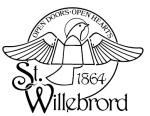Death Is Not To Be Feared
In the coming weeks the parish will invite you to remember your deceased loved ones and others from the parish and beyond. Each year we surround ourselves with the names of our beloved ones who died. You are given a chance to write the names of those who have died on an envelope, perhaps make a donation, and as soon as we are able around November 1st, we will add their names to the church walls surrounding the pews. Some people named have only recently died, and others have been gone for decades. Nonetheless, we remember them as part of the “communion of saints.”
The communion of saints is the traditional way to refer to all the people who are living, the people who have died, and specifically, those who have died and been declared “saints.” We profess our belief in that communion in the Creed. We are invited to reflect upon this three-part union, especially in the Eucharist. In every Eucharist we pray for ourselves who are gathered to worship, we remember those “who have fallen asleep…and await the resurrection,” and we invoke the on-going intercession of all the saints, especially our patron, St. Willebrord.
On the first Saturday of November after All Souls Day, we celebrate a Memorial Mass for all the deceased for whom we offered a funeral through our parish (just over 30 this year). Most of those funerals were celebrated within a Mass here at the parish with the body present. At some of the funerals we had the ashes, or cremains, present. Some of the funerals were services we provided at the funeral home itself. There is no Mass at a funeral home. Scriptures readings, intercessions, and special prayers of commendation are at the center of a funeral service at the funeral home.
In the Hispanic tradition a visit to a cemetery on All Saints and/or All Souls Day, and if possible, to the graves of loved ones is very important. At the cemetery loved ones may sing, tell stories of the deceased person, pray, cry, play music, and perhaps offer a toast in honor and memory of their loved one. Additionally, constructing an altar of memory to the dead in the home is a regular tradition. Altars are brightly decorated with colored paper, candles, favorite foods and beverages of the deceased, and perhaps a photo or something very personal by which to remember the person. Bones, skulls, and images of the dead may also be part of the altar display. All of this is done to show that death is not to be feared, that those who have died in the body, live in spirit. The altars also affirm our faith in Christ. In him we have a certain power over death. Death will not be the last word. Amen? Amen!
Peace, Fr. Andy
